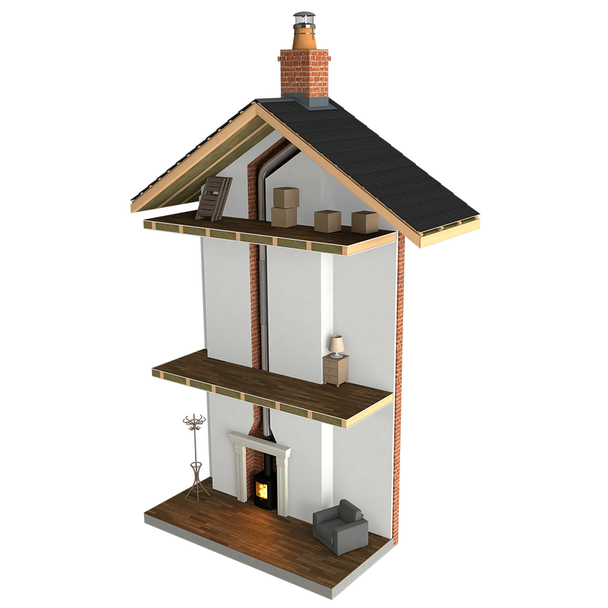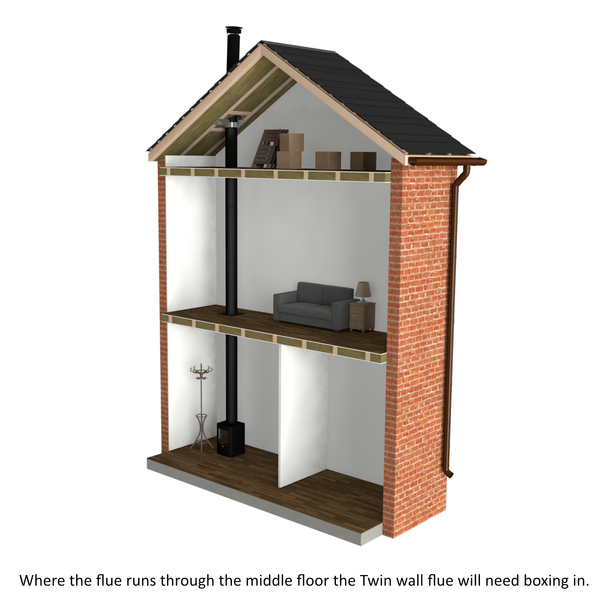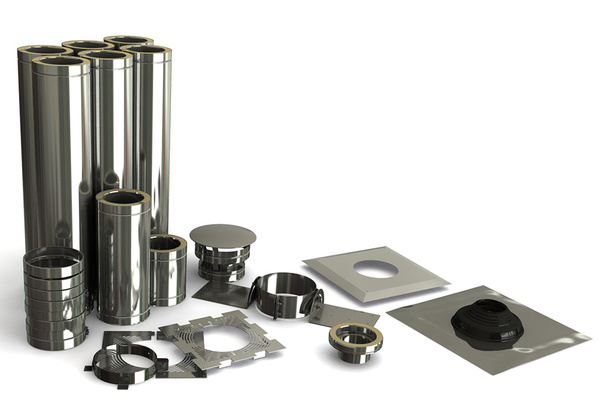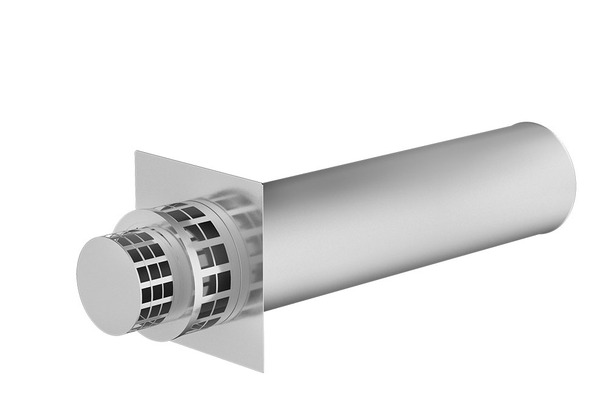What Are the Different Types of Chimney Flue?
Are you shopping for a new stove or heating appliance for your home? Well, before you go ahead and buy one, it’s important that you first check what type of chimney flue you have in your home. Not all appliances are suitable for all types of flues. So, if you want to know what type of stove or heating appliance you can install in your home, read our guide to the different types of chimney flues now.
What is a chimney flue?
Before we delve into the different types of chimney flues, let’s begin by defining exactly what we mean by a chimney flue.
As we set out in this article, the term chimney flue actually refers to two different, but related, things:
> Chimney - this is the structure that you actually see from the outside of your home. It’s the stack of bricks which creates a vent (or flue) which stretches from your fireplace or appliance up to the outside world. The inside of the chimney is the flue.
> Flue - this is the space or cavity within the chimney which allows the smoke and gases from your fire or heating appliance to exit out of, and away from, your home.
As you can see, these two elements combine to create what most people refer to simply as a chimney.
The different types of chimney flue
With that definition out of the way, let’s take a look at the different types of chimney flue. These different types of flue encompass chimneys that resemble the ‘traditional’ type found on many older homes, through to much more modern flues.
Class 1 chimney flue
Class 1 chimney flues are otherwise known as traditional chimneys. They are typically built from brick and are found on older properties (predominantly those built prior to 1960).
As you would expect from their age, class 1 chimneys are primarily designed to be used with open fireplaces burning wood or coal.
It’s important to note, however, that not all class 1 chimneys are the same. Depending on how it is lined, a class 1 chimney can fall into one of two categories:
Masonry parged class 1 chimney flues
Typically found on older homes, masonry parged flues are brick-built class 1 chimneys which are lined with a lime mortar.
Whilst very basic, these types of class 1 flues can accommodate almost any type of fire, stove or heating appliance.
Be aware, however, that because of the way they are lined, masonry parged flues are not particularly well-insulated which can lead to chimney draw issues.
Likewise, lime mortar has been known to soak up and accumulate combustibles such as soot and creosote - so it’s important that you have them inspected and swept on a regular basis.
Concrete, pumice and clay-lined class 1 chimney flues
It’s also possible to find class 1 chimneys which feature a concrete, pumice or clay lining.
These are usually either older class 1 chimneys which started out life with a lime mortar lining and have since been relined, or class 1 chimneys built after 1960 which featured a concrete, pumice or clay lining from day one.
Either way, concrete, pumice and clay are materials which have superior insulation properties compared to lime mortar. With improved insulation, you’ll benefit from improved fire performance.

Shop Now - 6” 316 Super Flex Chimney Flue Liner
Note - if you have a class 1 chimney flue which is lined with lime mortar, we recommend upgrading this to a concrete, pumice of clay lining, or using a chimney flue liner.
What types of fires and heating appliances can you use with a class 1 chimney?
It’s possible to use a wide range of different fires and heating appliances with a class 1 chimney.
Open fires tend to be the first thought when it comes to class 1 chimneys, however it’s also possible to use gas and electric fires. If you do wish to use a gas fire with a class 1 chimney, you should check that it is compatible. Many gas fires will be labelled as being suitable for class 1 use.
Class 2 chimney flues

Class 2 chimney flues (which are also known as prefabricated chimneys), are chimney flues which are constructed from interlocking flue pipes.
You’ll normally be able to identify a property with a class 2 chimney by the thin metal chimney which will exit from the roof, or up from one of the exterior walls of the property.
In some instances, you’ll find properties where the class 1 chimney has been converted into a class 2 chimney - by installing a prefabricated flue within the cavity of the existing class 1 chimney.
What types of fires and heating appliances can you use with a class 2 chimney?
Prefabricated class 2 chimney flues are normally around 5 inches in diameter (although this can vary). Because of this they are not suitable for use with solid fuels such as wood or coal.
Instead, class 2 chimneys are ideal for use with electric, gas and even gel fuelled fires, making them one of the most popular options for newer homes with modern heating appliances.

Shop Now - Twin Wall Flue Kit - 5” Stainless Steel - Double Storey Straight Up Internal System
If you want to install a class 2 chimney flue in your home, either as a standalone chimney, or within an existing class 1 chimney, then explore Trade Price Flues’ range of twin-wall flue systems.
Precast chimney flue
The third most common type of chimney flue found in British homes is the precast chimney flue.
A precast chimney flue consists of a series of hollow concrete blocks, which are built up through the walls of a home to create a chimney flue.
When the hollow concrete blocks reach the inside of the roof line, they are connected to a stainless steel pipe. This stainless steel pipe then exits through the top of the roof as either a GC1 terminal or ridge tile.
Precast chimney flues are most commonly found in new build homes.
What types of fires and heating appliances can you use with a precast chimney flue?
Precast flues are similar in construction and characteristics to class 2 chimneys. As such, we recommend that you only use gas or electric fires with a precast chimney flue.
Remember, if you’ll be using a gas fire with a precast chimney flue, ensure it is suitable for use with class 2 chimneys.
Balanced flue

Shop Now - Stainless Steel Gas Fire Horizontal Terminal 100-150mm
A balanced flue is used with a glass-fronted gas fire and vents directly out of the exterior wall behind the fire.
As such, a balanced flue will be at ground level and resembles a small pipe sticking out of your home’s wall (the flue will sometimes be caged in a metal box or surround).
Balanced flues normally operate in a ‘co-axial’ fashion, meaning there is a flue pipe that sits within a larger flue pipe. The small flue pipe will normally expel exhaust gases from the gas fireplace, whilst the larger pipe draws in fresh air to keep the fire supplied with the oxygen it needs to burn.
What types of fires and heating appliances can you use with a balanced flue?
Balanced flues can only be used with balanced flue gas fires. They are not suitable for use with other types of fire or heating appliances.
If you want to install a balanced-flue gas fire in your home, check out Trade Price Flues’ range of balanced flues for gas fires now.
No chimney flue
In some instances, depending on the type of heating appliance you’re trying to use, you won’t need a chimney flue at all.
Appliances such as flueless gas fires don’t require a flue full stop. They work using a built-in catalytic converter to clean any fumes that are produced by the fire. Having said that though, flueless gas fires do require you to install a ventilation brick on an external wall.
The home of chimney flue suppliers
Whether you’re looking to line a class 1 chimney or install a completely new twin-wall flue system, you’ll find everything you need to get the job done here at Trade Price Flues.
With free UK wide delivery when you spend over £150, competitive prices and industry-leading customer service, there’s no better place to pick up your flue supplies than Trade Price Flues.
Shop flue supplies at Trade Price Flues today
For more chimney and flue advice, read the Trade Price Flues blog…
Why You Should Insulate Your Chimney Flue | The Causes of Chimney Downdraft and How to Prevent It | Balanced Flue or Conventional Flue: What’s the Difference?
Latest Articles
-
Air Pollution Down in the UK Despite Record Wood Burner Sales
Great news! Wood-burning stoves, once considered environmental villains, have transformed into eco-f …18th Apr 2024 -
A Guide to Stove Installation in Lodges, Sheds, and Shepherd’s Huts
Shepherd’s huts, lodges, and sheds have become increasingly popular as charming retreats or alternat …25th Mar 2024 -
Pinned vs. Pinless Moisture Meters: Which is Best for Firewood?
When you collect or buy firewood, it usually starts very moist inside. Using sopping wet wood to bur …4th Mar 2024






